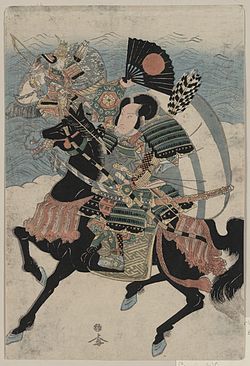You can help expand this article with text translated from the corresponding article in Japanese. (July 2022) Click [show] for important translation instructions.
|
| Battle of Ichi-no-Tani | |||||||
|---|---|---|---|---|---|---|---|
| Part of the Genpei War | |||||||
 Folding screen painting, Kano School | |||||||
| |||||||
| Belligerents | |||||||
| Minamoto clan | Taira clan | ||||||
| Commanders and leaders | |||||||
| |||||||
| Strength | |||||||
| 3,000[1] | 5,000[1] | ||||||
| Casualties and losses | |||||||
| Unknown | 1,000[1] | ||||||
The Battle of Ichi-no-Tani (一ノ谷の戦い, Ichi-no-Tani no tatakai) was fought between the attacking Minamoto clan and the defending Taira clan at Suma, to the west of present-day Kobe, Japan, on 20 March 1184. It sat on a very narrow strip of shore, between mountains on the north, and the sea to the south. This made it quite defensible, but also made it difficult to maneuver troops inside the fortress. The Taira suffered a crucial defeat to the forces of Minamoto no Yoshitsune and Minamoto no Noriyori.[1]
Battle
[edit]
Minamoto no Yoshitsune split his forces in two. Minamoto no Noriyori's forces attacked the Taira clan at Ikuta Shrine, in the woods a short distance to the east. A second detachment, no more than a hundred horsemen under Yoshitsune himself, attacked the Taira at Ichi-no-Tani from the mountain ridge to the north. At the chosen hour, the Minamoto forces attacked causing confusion among the Taira who neither deployed nor retreated. Only about 3,000 Taira escaped to Yashima, while Tadanori was killed and Shigehira captured.[1] Also killed from the Taira clan were Lord Michimori, Tsunemasa, Atsumori, Moromori, Tomoakira, Tsunetoshi, and Moritoshi.[2]: 117, 123
Ichi-no-Tani is one of the most famous battles of the Genpei War, in large part due to the individual combats that occurred here.[3] Benkei, probably the most famous of all warrior monks, fought alongside his lord Minamoto no Yoshitsune here, and many of the Taira's most important and powerful warriors were present as well.[4]
Ichi-no-Tani is the last recorded instance in which crossbows were used in a Japanese siege.
Legacy
[edit]The death of Taira no Atsumori at the hand of Kumagai no Naozane during the battle is a particularly famous passage in the Heike Monogatari.[2] It has been dramatized in noh and kabuki, and in popular fiction, Oda Nobunaga is often portrayed as performing the noh at his own death (ningen goju nen geten no uchi wo kurabureba, yumemaboroshi no gotoku nari) in Honnō-ji Incident. The death of Atsumori is arguably among the most celebrated acts of single combat in all of Japanese history.
Gallery
[edit]-
Scene from the battle, detail from screen painting
-
The encounter between Kumagai Naozane and Taira no Atsumori, woodblock print, circa 1820
-
Attack down the slope on the Taira camp
-
Encounter between Naozane (right) and Atsumori (left), screen painting
-
View today of the narrow coastal strip where the battle took place
-
Monument at the site of the battle
See also
[edit]References
[edit]- ^ a b c d e Sansom, George (1958). A History of Japan to 1334. Stanford University Press. pp. 298–299. ISBN 0804705232.
{{cite book}}: ISBN / Date incompatibility (help) - ^ a b Sato, Hiroaki (1995). Legends of the Samurai. Overlook Duckworth. p. 117. ISBN 9781590207307.
- ^ Turnbull, Stephen (1998). The Samurai Sourcebook. Cassell & Co. p. 204. ISBN 1854095234.
- ^ Turnbull, Stephen (1977). The Samurai, A Military History. MacMillan Publishing Co., Inc. pp. 66–71. ISBN 0026205408.





